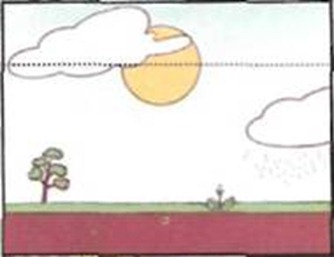





Time to add more colour to the garden, first with the giant-flowering sunflower, North America’s biggest, brightest annual, widely grown for its nutritous seeds: eat your own crop or feed your pets when flowering’s over. Time to get the marrows/ squashes into the ground, delicious subtropical vegetables, but to succeed they need a little more loving than most. And definitely time to declare war on weeds; we tell you the options open to you: you choose.
Needs list: 1 pkt sunflower seed; 1 pre-sown pkt marrow/squash seed, 1 pkt 3 in diameter peat pots; 1 cwt/50 lb bag moss peal.
Time budget: 4 hours in 2 weeks
 Weather dry, sunny: soil warm, workable. Take stock of the garden, now, before lush June masks the differences. Note where the favoured spots in the garden are, and where-cold, damp soil or draughts retard growth. Avoid the cold, backward areas when deciding where to put the patio and tree.
Weather dry, sunny: soil warm, workable. Take stock of the garden, now, before lush June masks the differences. Note where the favoured spots in the garden are, and where-cold, damp soil or draughts retard growth. Avoid the cold, backward areas when deciding where to put the patio and tree.
America’s mightiest contribution to the world of annual flowers is the annual sunflower, Helianthus aminus. This is a veritable jack-and-the-beanstalk plant, shooting up 10 or 12 ft. in six months, with large hairy leaves and a flower at the top at least the size of a dinner plate. Plant it at the foot of a south wall in a trench full of elephant manure, and you’ll get it 15 ft. tall – no trouble. The world record is around 22 ft. Try that for size! For real garden effect you don’t want them to get much over 5 ft., so plant them close – 18 – 24 in. apart. Your flowers will be as big, but the plants won’t overpower everything else. Iiesides, they won’t need staking. Plant 6 in in front of a wall.
War on weeds is essential if you are to cultivate your plot successfully. If they get a hold they’ll crowd out the plants you want to grow. Life-gets easier once your garden gets established. Concentrate on areas under cultivation; in large areas or areas you can’t control effectively use ground cover plants or simply mow the weeds. Anyway – what is a weed ? Useful definition – a plant out of place. Usually a wild plant that has invaded your plot. 3 ways you can deal with weeds. (1) hand weed (2) hoeing (3) chemical methods. 1 and 2 are to be preferred.
Hand weeding is laborious but effective. Hoeing severs the growing top of the weed from its roots, forms green manure and a natural mulch of powdered soil. There are 3 types of weedkillers to choose from (1) total herbicides: these kill all plants in sight. (2) selective weedkillers-used mainly on lawns where they kill broadleaved plants like daisies, dandelions, but leave the grass growing. (3) pre-emergence weedkillers, which kill weed seeds before they come up. Use chemicals only as a last resort. If misused they kill people as well as weeds.
Your biggest task this fortnight will be to get your marrows/squashes/ courgettes/pumpkins off to a good start. All are closely related: you grow them all the same way. Courgettes, in passing, are simply a type of marrow/squash that has been specially bred to pick very small. All marrows/squashes etc., taste best if you pick them half to two-thirds the size the catalogues say they’ll grow to. Don’t wait till the outside feels like sunbaked rhino hide; by then they’re inedible. Start by digging over an area of bare earth, clearing the weeds, stones, you know the drill by now. Then make a hill of compost or soilless growing mix 3 ft. across, about 1 ft-18 in. high, hollowed in the centre. At the bottom of the hollow place half a bucketful of well-rotted farmyard manure or any other organic manure. Mix well. Top over with more soilless growing mix, still leaving a slight depression at the top of the hill.
Plant 3 peat pots each with 2 marrow/squash seeds in them, pressing the pointed end into the growing mix. Thin out the weaker seedling of each pair 2 weeks later. Then plant the peat pots in the hills. Plant as close to the rim of the hill as you can, and plant the pots deeply, rims buried by about 1 in. Soak. Soak the hill weekly till you harvest. These plants need water.
Mature marrows/squashes are 94.6% water, so it takes a lot of water to produce a crop. If you don’t choose all female self-fertile marrows, you’ll have to pollinate the flowers. Transfer pollen from male flowers (the ones with a cone in the middle) to the female flowers with a small paint brush. Or just push the male flowers into the female ones. If you don’t pollinate, your marrows/squashes will be too bitter to eat. The plants are vigorous, sprawling things so allow them plenty of room. You’ll get a head start if you start seeds indoors.
Two Hour Gardening Project: Stage 26 Climbing Plants and Pergolas
Two Hour Gardening Project: Stage 25 Getting To Know Your Garden
Two Hour Gardening Project: Stage 23 Principles of Pruning
Two Hour Gardening Project: Stage 22 Rock Gardening
Two Hour Gardening Project: Stage 20 Tubs and Container Gardening
Two Hour Gardening Project: Stage 18 Choosing Shrubs for the Garden
Two Hour Gardening Project: Stage 17 Fan Trained Fruit Trees
Copyright © www.100flowers.win Botanic Garden All Rights Reserved